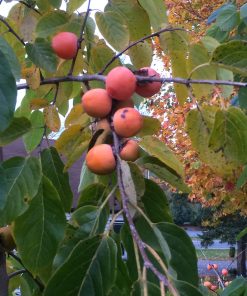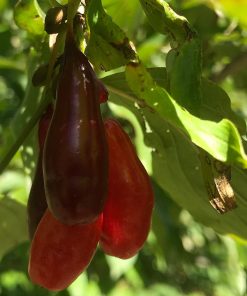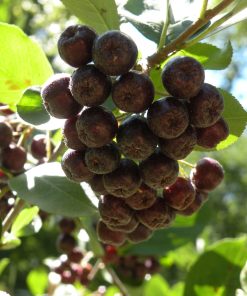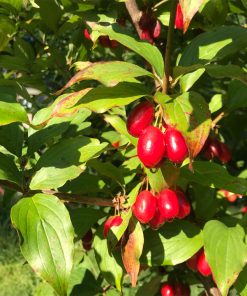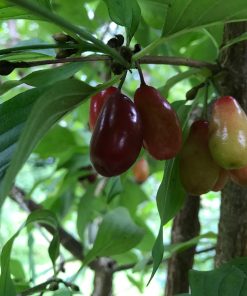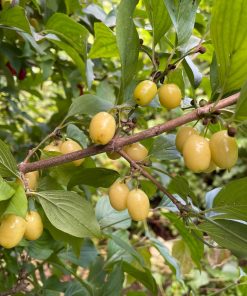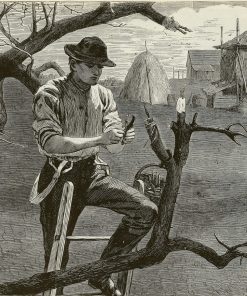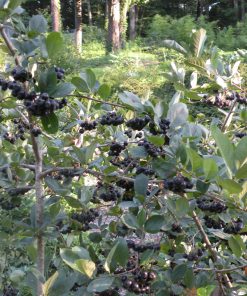Asimina triloba, Cricket Hill Garden Select Pawpaw Cricket Hill Garden
$ 32,00 $ 19,20
Asimina triloba, Cricket Hill Garden Select Pawpaw
Variety description: These seedling pawpaws are grown from the many named varieties of pawpaws we have fruiting in the landscape. Some of the parent trees include: ‘Taytwo,’ ‘Overlease,’ ‘NC-1,’ “IXL,’ ‘Qauker Delight,’ as well as the Peterson pawpaws.
Theses trees will have superior fruit in terms of size and flesh to seed ratio as compared to trees grown from wild collected seed. These trees are also likely to be well suited for the northern tier of the pawpaw’s range, since they are grown from fruit which ripened well in our cool USDA zone 6 climate.
With good care, these seedling should begin the fruit 5-6 years after planting. Cross pollination from two genetically distinct plants necessary for fruit to set. Trees should be planted no more than 20′ apart to ensure good pollination.
A relative of the tropical Custard Apple, the large, pointed oval foliage of pawpaws contribute to their exotic appearance. Mango shaped greenish-brown fruit weigh between 4 oz and 1 lb, making this the largest fruit native to North America. Ripe fruit have soft, juicy flesh and taste like banana custard with notes of pineapple and mango. Very good for fresh eating or for use in baking. Larvae of the zebra swallowtail butterfly (Eurytides marcellus), feed exclusively on young leaves of pawpaws.
Site requirements: Full sun location with evenly moist soil. Pawpaws will grow in the shade but fruit set will be poor.
Size at maturity: Trees can be maintained at about 15′ tall. Pawpaws sucker readily.
Pests and diseases: None.
Hardiness: Native from New York west to southeastern Nebraska, and south to northern Florida and eastern Texas. Will grow in USDA zones 5-9.
Plant size: 2 year old seedling, about 6-8” tall with a well developed root system. Will likely produce fruit in 4-5 years if given good care.
When we ship: Available for FALL 2024 shipping.
Shipping restrictions: None.
| Number of Plants | 1 |
|---|
Fast Shipping and professional packaging
We offer a wide range of shipping options due to our long-standing partnerships with UPS, FedEx and DHL. Our warehouse staff will package all goods to our exacting specifications. Prior to shipping, your goods will be thoroughly inspected and secured. We ship to thousands customers every day across multiple countries. Our commitment to become the biggest online retailer around the globe is evident by this. The warehouses are located situated in Europe in the same way as they are in USA.
Orders with more than one item are assigned processing times for each item.
We will carefully examine all items ordered before shipping. The majority of orders are delivered within 48 hrs. The delivery time will be between 3-7 days.
Returns
Due to multiple entities which include the factory as well as the warehouse, we cannot effectively manage inventory. The stock levels may fluctuate at any time. It is possible that your order may be out of stock once your order has been made.
Our policy is for 30 days. If 30 days have gone without a trace since the purchase however, we're unable to give you a return or exchange.
The item must not be used, and it must be in the original packaging. It should also be returned in its original packaging.
Related products
Landscape edibles
Landscape edibles
Landscape edibles
Landscape edibles
Landscape edibles
Landscape edibles
Cornus, open-pollinated seedling of ‘Elegant’ Cornelian Cherry Cricket Hill Garden
Landscape edibles
Elaeagnus multiflora, ‘Sweet Scarlet’ Goumi SPRING 2025 PRE-ORDER Cricket Hill Garden
Landscape edibles
Landscape edibles
Landscape edibles
Diospyros virginiana, Persimmon seedling Cricket Hill Garden
Landscape edibles
Landscape edibles
Landscape edibles
Cydonia oblonga, ‘Meech’s Prolific’ Quince Cricket Hill Garden
Landscape edibles
Cydonia oblonga, ‘Bourgeault’ Heirloom French Quince Cricket Hill Garden
Landscape edibles
Aronia melanocarpa, ‘Viking’ SPRING 2025 PRE-ORDER Cricket Hill Garden
Landscape edibles
Cydonia oblonga, ‘Tekkes’ Turkish Quince Cricket Hill Garden
Landscape edibles
Landscape edibles
Landscape edibles
Landscape edibles
Landscape edibles
Landscape edibles
Cudrania, ‘Daniecki’ male Che Chinese Melonberry SPRING 2025 PRE-ORDER Cricket Hill Garden
Landscape edibles
Landscape edibles
Landscape edibles
Landscape edibles
Landscape edibles
Landscape edibles
Aronia melanocarpa, ‘Nero’ SPRING 2025 PRE-ORDER Cricket Hill Garden




